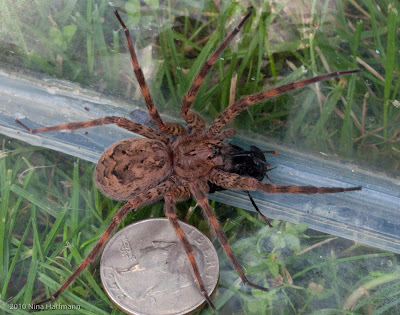I’ll get back to sharing Michigan’s wonderful adventure soon enough.
But, let’s press pause, set the cool air and fresh breezes aside for a moment, and catch up with a bit of excitement I found in my very own southern Ohio back yard.
After all, what would a sultry summer day be, without tales of long-legged hairy spiders to keep you awake long after darkness has fallen?
You know you won’t sleep soundly anyway. These still, muggy nights can be long, so go ahead…check out these giants of the invertebrate world in my very own version of...
The Spider and the Fly.
My morning walk through the field and past the pond produced just what I had hoped—an offering of food for the guest spider waiting for me at home in a small glass case since being discovered in a corner of the front porch Sunday afternoon. Yesterday’s meal had been quite fine, one large grasshopper, who was quickly snatched and devoured by the hungry arachnid.
This morning, barely a shell remained in the corner of her cage.
The rest had been sucked dry.

A plump horse fly lazily waking on a stone in the sunshine was an easy mark. It turned slowly to look at me, with broad and dark compound eyes spaced just a bit apart— a female, and with the sturdy prominent mandibles able to inflict a serious bite. Males survive on nectar and lap sweet juices, while the female flies must have a meal of blood before laying their eggs. In a moment I had her wrapped in my hand, headed for home, a hungry spider waiting.

In the summer, you’ll likely find a guest of some sort staying with me.
Caterpillars, praying mantids, frogs, spiders—I learn from watching them more closely, never detain them for more than a couple of days, and turn them loose immediately if they won’t eat. A small glass tank is usually the perfect set-up to keep them safe and sound while I stick my nose in their business. Then they’re turned back to the wild in as close to the place as I found them, no harm done.
The spider was waiting as I knew she would be.
A large common fishing spider, Dolomedes tenebrosus, her dark banded legs could easily cover my palm. Over an inch in length, her body was covered in dense, short, chocolate brown hair.
Eight shiny, black button eyes stared back from within the glass case.
Fishing spiders are members of the family Pisauridae, nursery-web spiders.
Almost as large as wolf spiders (and in the case of mature females, perhaps larger) fishing spiders carry their eggs in a sac until ready to hatch, then construct for the spiderlings a small silken enclosure, in front of which they stand guard. Wolf spider females carry their already hatched young on their backs. What looks at first glance like fur is a writhing mass of legs and bodies--hundreds of tiny spiders!

The arrangement of the spiders’ eyes is different, as well. While both spiders have eight eyes, those of fishing spiders are divided into just 2 rows of 4 each. Wolf spiders have 3 rows of eyes—3 on the lowest level, 2 large ones in the middle and 2 small ones on top. So, if you ever need a quick and easy ID, look closely at that furry little face!
Named for their ability to take small fish from the water as they stand on the surface, the common fishing spider is actually a tree-dweller, most at home in wooded areas near water and a common hunter by night.
She’d wandered onto the porch from the woods and become quite a visible spider-shaped spot against the white brick of the old farm house.
As I had guessed, this very large spider was quite pleased with what I had scared up for breakfast.
The very large fly, on the other hand, was not at all pleased with the my hospitality.





















































